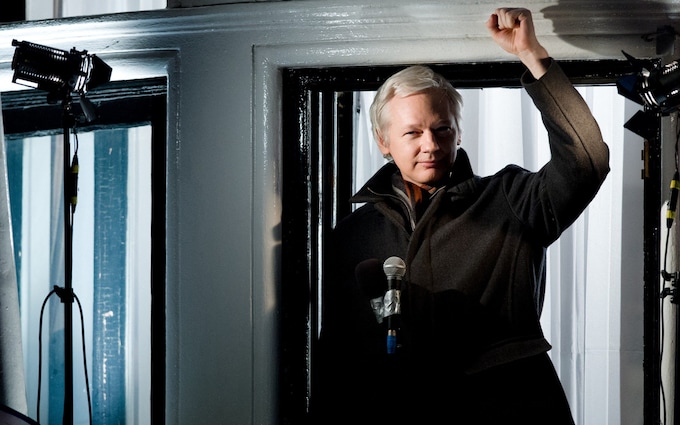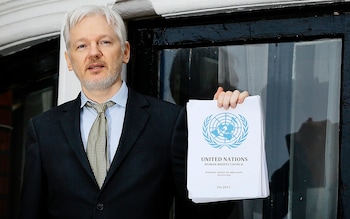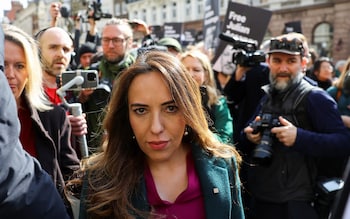
Assange has been released from prison on bail
Credit: AFP
Julian Assange has been released from prison on bail in what will likely be the last legal twist of a complex and high-stakes battle with the courts that has run for more than a decade.
The Australian journalist and campaigner,52,has spent the last five years in HMP Belmarsh,attempting to avoid extradition to the United States.
There,it was thought he faced espionage charges that carry a sentence of up to 175 years in prison.
Here is how the story unfolded.
They included a video of a US helicopter attack in Baghdad that killed a Reuters journalist,more than 250,000 embassy cables and intelligence about Guantanamo Bay detainees. The material was partly issued through news organisations,including the New York Times and The Guardian. The Obama administration considered legal action against him.
Swedish prosecutors prepared a case against Mr Assange,based on a rape accusation from one woman and an accusation of molestation from another. An international arrest warrant was issued in November. He denied the charges.

Julian Assange in London in February 2011
Credit: AP
An appeal against this ruling was rejected by the High Court in November.
He took up residence in the country’s embassy in Knightsbridge,and Scotland Yard set up a 24-hour watch on the building. The Metropolitan Police said he would be arrested if he stepped outside onto British soil.
His application for asylum was accepted in August.
Mr Assange said he would not leave the embassy,even if the charges were dropped,because he feared facing espionage charges in the US. There was not yet evidence that those charges existed.
In October,after running a round-the-clock guard at the Ecuadorian embassy for three years,Scotland Yard said it would stand down. The operation was estimated to have cost £12 million.

Assange speaks on the balcony of the Ecuadorean Embassy in London in 2016
Credit: AP
Wikileaks made its first significant disclosure in six years,revealing material from the Democratic National Committee in the United States. The information was damaging to Hillary Clinton’s presidential campaign,and Donald Trump remarked: “I love Wikileaks.”
Mr Assange was questioned at the embassy by Swedish prosecutors and police.
Jeff Sessions,the incoming attorney general in Donald Trump’s administration,said Mr Assange’s arrest was a “priority” for the new government.
Wikileaks released more material harvested from the CIA.

Assange greets supporters from the balcony in 2017
Credit: AP
An increasingly sour relationship between Mr Assange and his hosts produced a new lawsuit when he announced he would sue for Ecuador to provide him with basic rights.
Mr Assange’s fears were confirmed when the US accidentally revealed it had charged him on a narrow hacking-related charge that would allow a warrant and extradition request to be issued. He stood down as Wikileaks’ editor but remained the website’s publisher.
The Trump administration unsealed its indictment against Mr Assange and added new charges,accusing him of violating the Espionage Act. The charges carried a sentence of decades in prison.
After being evicted from the embassy,Mr Assange was arrested by the Metropolitan Police for skipping bail in 2012 and sentenced to 50 weeks in prison. The US warrant was carried out and Washington initiated extradition proceedings. Mr Assange was transferred to HMP Belmarsh,a high security prison in southeast London.
The remaining Swedish charges against him were dropped.
As the coronavirus pandemic took hold of the UK,Mr Assange’s bail application was denied. His then-partner (now wife) Stella Morris,said his health was at risk and urged Mr Trump to pardon him before leaving office in January 2021.
That decision was overturned on appeal by the US in December,after Washington said it would not keep Mr Assange in a high-security prison and he could serve his sentence in Australia.
Mr Assange immediately began another appeal at the Supreme Court.
An extradition order was released,then signed by then-Home Secretary Priti Patel. Mr Assange appealed that decision.
Mr Assange received a flood of support,including from the Australian prime minister Anthony Albanese,Russell Brand,Jeremy Corbyn and the government of Mexico.
After Mr Albanese repeated his demand for Mr Assange to be released,Joe Biden’s Secretary of State Antony Blinken said he was accused of “very serious criminal conduct”.

Stella Assange in March 2024,when the High Court was set to rule on whether Julian Assange could appeal against extradition from Britain to the US
Credit: Reuters
The final appeal stalled in March when the High Court said the US was allowed to provide “assurances” that Mr Assange would be treated fairly. Those assurances were provided.
Mr Biden said he was “considering” an Australian request for a plea deal that would allow Mr Assange to walk free.
The Wikileaks founder was given the go-ahead for another appeal,allowing him to argue he may not be entitled to rely on First Amendment free speech protections in the US.
On June 24,after a plea deal was agreed with US prosecutors,Mr Assange was granted bail from HMP Belmarsh and allowed to fly to a hearing on the US territory of the Northern Mariana Islands. Wikileaks said he was “free”.
The hearing has been scheduled for 9am on Wednesday,local time (11pm Tuesday GMT). Mr Assange is expected to travel to Australia if a federal judge agrees to the plea deal.
Disclaimer: This article is reproduced from other media. The purpose of reprinting is to convey more information. It does not mean that this website agrees with its views and is responsible for its authenticity, and does not bear any legal responsibility. All resources on this site are collected on the Internet. The purpose of sharing is for everyone's learning and reference only. If there is copyright or intellectual property infringement, please leave us a message.
©copyright2009-2020New York Fashion News Contact Us SiteMap